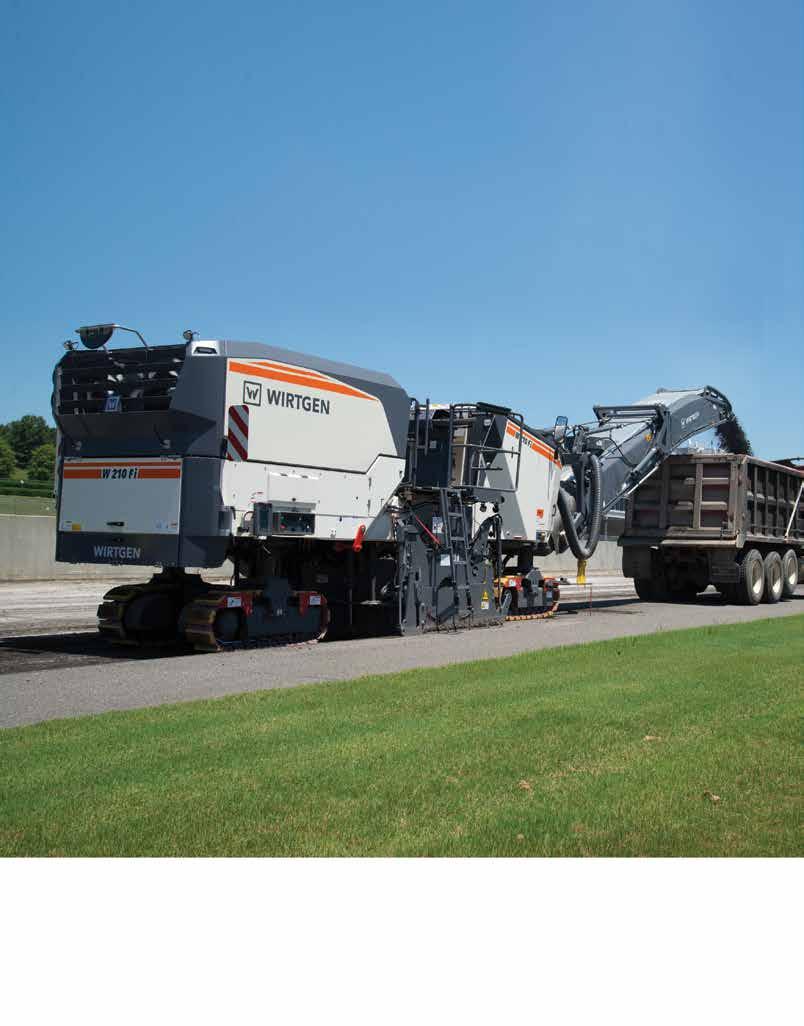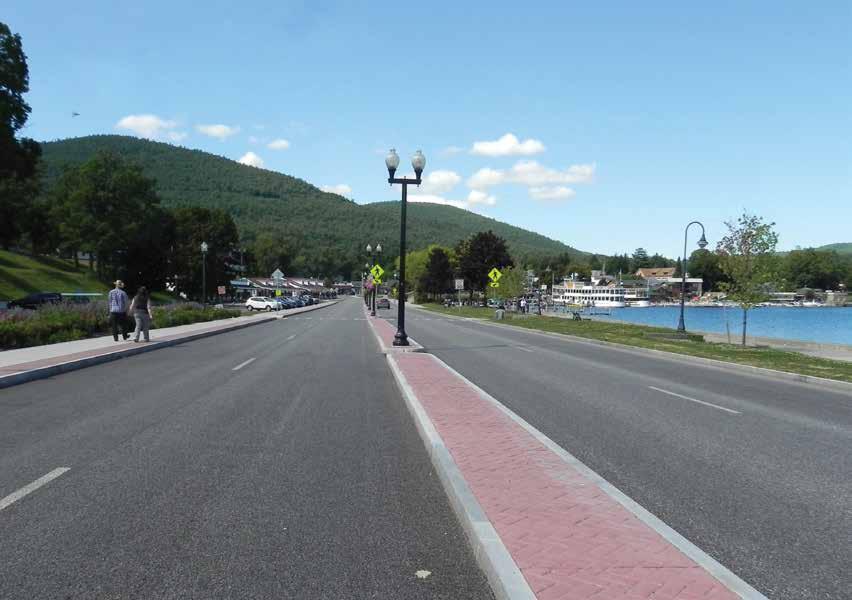
17 minute read
Best Practices of Porous
BEST PRACTICES OF POROUS ASPHALT PAVING
BY SARAH REDOHL
Experts share best practices for performing porous asphalt paving, from W project planning to maintaining the road well after it’s paved. When Bruce Barkevich received a call from the Lake George Association (LGA) about using porous asphalt on a local project, he was initially concerned about how a permeable pavement would perform under the roadway’s conditions. The association board members hoped to use porous asphalt on Beach Road, located on the south end of the pristine Lake George in the Adirondack Mountains of New York. However, the project presented a number of obstacles for its use. LGA, Warren County, and the Warren County Soil and Water Conservation District teamed up with Barton & Loguidice (B&L), D.P.C., Albany, New York, to research the feasibility of implementing a porous roadway along Beach Road. Some of the major constraints were that the water table beneath the road was higher than typically seen for permeable pavement projects; porous asphalt is not usually recommended if the water table is less than 48 inches beneath the bottom of the reservoir stone layer. Additionally, sediment from a nearby stream that often flooded could clog the porous pavement.
Lastly, Beach Road receives more traffic than the types of roads for which the state had used porous asphalt in the past, with a total aver age daily traffic count of 8,600 with 5 percent being heavy truck traffic.
The project team worked with the NYS Environmental Facilities Corporation (NYS EFC) and was awarded a Green Innovations Grant to help offset the additional costs of design and construction of what was to be a Heavy Duty version of porous asphalt with the capacity to accommodate the variable lake elevation water table depths and the heavier traffic loading.
“New York, and specifically the capital district, has been doing porous pavements going back into the 1970s,” Barkevich said. In the state’s early days of porous asphalt, its application was limited to parking lots. However, Barkevich said, recent successes using porous pavements on residential and road projects have expanded its use.
Beach Road was one of those projects.
“That project was so successful, it opened up the possibility of us ing porous asphalt on a lot of roads in the state,” Barkevich said. Not only were they able to overcome each concern, but the project also propelled the New York Department of Transportation and B&L to co-author a specification for porous asphalt. “We’re getting more cre ative with applications for porous pavements.”
PERMEABLE PAVEMENT IN THE EMPIRE STATE
Barkevich is the Vice President of the New York Construction Materials Association, the trade association that represents asphalt, readymix concrete and aggregates in the state. Barkevich has 32 years of experience in the asphalt industry, so he’s become the association’s “asphalt guy.” During his 16 years with the association, Barkevich has worked with a variety of owners and agencies on porous pavements.
A permeable pavement is a specific type of pavement that enables infiltration of stormwater runoff. This includes either pervious con crete or porous asphalt, said Barkevich in his presentation “Permeable Pavements for Stormwater Management” presented at CONEXPO-CON/AGG 2020.
The goal is to allow water to pass through the pavement into a stor age reservoir beneath the pavement and then into the ground.
“In conventional paving, we don’t want water to get into the pavement structure and we aim to get it off to the shoulder, into ditches and closed
“Normal asphalt pavements are designed for 4 percent air voids, whereas a permeable pavement will be somewhere in the 20 percent air void range.”—Bruce Barkevich
drainage systems,” Barkevich said. “We have to change our mindset that water is bad if we want to take advantage of this unique concept.”
A porous pavement and open graded friction course (OGFC) are very similar and can be close to the same air-void ratio since they both use a uniform aggregate size with minimal amounts of fines, said Thomas Baird. He is a partner at B&L and was the design supervisor and project manager on the Beach Road project. Since 2012, Baird has provided porous asphalt training to local, county, state, and en vironmental organizations throughout the U.S. at more than 50 conferences and events, including the last three World of Asphalt conferences and CONEXPO-CON/AGG in 2020.
“OGFC is used primarily to improve skid resistance especially in wet weather conditions,” Baird said. “Porous pavement is utilized to convey and/or treat stormwater and it also has improved wet weather friction over conventional asphalt surface courses.”
POROUS ASPHALT HAS ITS BENEFITS Permeable pavements present a number of benefits.
From a safety perspective, Baird said the use of porous asphalt can lead to reduced glare and road spray during wet weather

The Beach Road porous pavement project propelled the New York Department of Transportation and Barton & Loguidice to co-author a specification for porous asphalt.

conditions, as well as improved friction and less hydroplaning. As a result of no capillary action present on porous pavements, they are also less susceptible to frost and encounter little to no black ice, thus requiring less de-icing materials.
This was a primary goal for the Beach Road project. As outlined in an article in National Geographic, salt runoff from de-icing activities was becoming a major concern for the health of Lake George. The use of porous pavement reduced the amount of salt and other contaminants originating from applications on Beach Road by approximately 50 percent, Baird told National Geographic at the time.
“Pavements hold pollutants, from litter to oils and other products that drip from vehicles,” Barkevich said. With a standard dense-graded pavement, water that washes across the pavement carries these products with it and can introduce these contaminants into a storm or sewer system. When the water instead infil
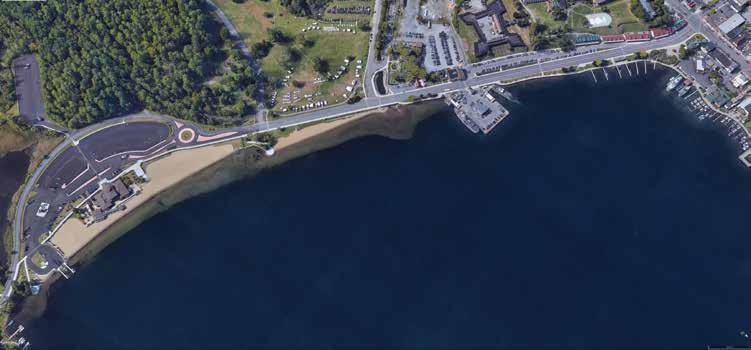
trates the pavement, these contaminants are left behind to be vacuumed or handled as part of the maintenance operations of the parking lot or city street, Baird and Barkevich explained.
Not only does porous asphalt reduce runoff and act as an effective pollutant treatment, but it also helps to recharge groundwater supply.
“Creative engineers and architects will look for ways to dump other water onto these porous pavements,” Barkevich said. “Roofs are impermeable, so this gives them another way to use that water.” For example, connecting the retention basin to supply water to lawns, gardens or trees.
Porous pavements must be installed as a system. “Only providing a top permeable layer has been attempted in the past,” Baird said, “however, it was met with failure once the water could not run off the top pavement layer with clogged edges.”
Since permeable pavements offer a reduced environmental footprint and improved water quality, they also allow owner/agencies to take advantage of credits under the U.S. Green Building Council’s Leadership in Energy & Environmental (LEED) certification program.
“LEED wasn’t built around pavement and site developments, but around buildings—glass, insulation, roofing,” Barkevich said. “Porous asphalt gives engineering firms a chance to get a couple more credits they might need to get LEED certified, in addition to getting the water where it belongs.”
Porous asphalt can also be an economical choice, not only for its reduced use of de-icing materials but also because they require little to no closed drainage systems.
Some communities in New York, Barkevich said, use a consolidated drainage system, meaning its sewage and stormwater runs in one pipe that is treated and then ultimately is discharged into the Hudson River. “Every so often, we get that peak flow that the system can’t manage and we get overflow situations,” he said. “It’s a huge problem for a lot of urban areas in the U.S.”
Porous asphalt is a stormwater management tool that can reduce storm sewer loads and stormwater fees, or even eliminate the cost of conventional stormwater man agement systems, as well as minimize debris collecting in drainage swales.
Baird said porous pavements can also reduce passenger car traffic noise by 1 to 3 dBA.
PROPER PROJECTS FOR POROUS PAVEMENTS
Baird and Barkevich warn that porous pavements aren’t ideal for every roadway. Baird said porous asphalt works well for parking areas, as well as low volume and low speed roads, preferably roads with limited truck traffic and a speed limit of 35 mph or less. He also cautions against the use of porous asphalt for approaches to traffic signals, tight parking lots or parallel parking. Ideally, porous asphalt parking lots would offer an 18-foot or wider driving lane, angled parking, and 8.5 to 9-foot wide parking spaces. These conditions help reduce the amount of wheel turning and maneuvering by drivers that stress the porous pavement structure.
Baird added the importance of assessing possible contamination and damage from off-site silt and sediment or other pollutants sources, as well. Pre-filtering of off-site runoff and from landscaped or wooded areas may be required to help reduce the risks of clogging the pores in the asphalt.
For example, in the case of Beach Road, the surrounding mountainous terrain drains to the lake. Under heavy storm conditions, erosion occurring even miles away can reach the lake along local roadways and eventually Beach Road, Baird said. “The design incorporated intercepting drainage structures and hydrodynamic separators to collect this silt and sediment-laden stormwater, clean it and send it to the lake prior to reaching the porous pavement.”
Additionally, the reconstructed sidewalks and multi-use paths were sloped away from the pavement towards vegetated areas that infiltrate, as opposed to typical construction where sidewalks drain towards the roadway.
It’s also important to note that not every type of soil can support a permeable pavement. Barkevich provides the example of an area along the Hudson River with “the bluest clay” he’s ever seen. “Not only won’t water infiltrate it, but the clay even swells in water,” he said. “I would never consider a porous system there.”
Barton & Loguidice has recently developed a porous asphalt system that can be utilized where clay exists and where water tables are very high, Baird said. The first projects with this B&L design are in the cities of Rensselaer and Mamaroneck, New York. Both projects are funded through the Green Innovations Grant Program through NYS EFC using funds from the U.S. Environmental Protection Agency.
Barkevich looks for an infiltration rate of ½ an inch per hour, though he’s seen porous systems built for an infiltration rate of 1/10 of an inch per hour. Slow draining systems will require increased depth of the retention basin.
ASPHALT PLANTS AND COMPONENTS

www.tarmacinc.com
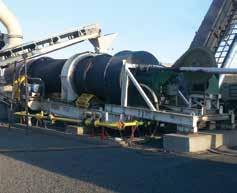

contact tarmac at 816-220-0700 or info@tarmacinc.com

“Porous pavement isn’t a catch all, but it’s another tool in the toolbox,” Barkevich said. And, like any other asphalt pavement, proper application is key.
SITE PREPPING FOR POROUS ASPHALT
Before placing the reservoir course, a non-woven geotextile fabric should be placed on the uncompacted subgrade to add stability. “It’s also imperative that the geotextile extend vertically against the adjacent subgrades to avoid adjacent materials from migrating horizontally into the voids of the stone courses and causing settling in the undermined areas and frost susceptibility into the new porous structure,” Baird said.
Next comes the reservoir course layer of stone that varies from 12 to 36 inches, depending on the project specifics. The reservoir course should aim for about 40 to 45 percent air voids. Baird achieves this by combining 4 and 4A stone. “It really locks together while still getting us 40 percent air voids,” he said.
On top of the reservoir course is the choker course, which is a thin layer of stone that stabilizes the larger stone reservoir course and creates a stable, flat and rut-free paving surface. According to the B&L design, the larger reservoir course stone is graded and compacted up to the elevation of the bottom of the proposed asphalt layers.
Barkevich said the choker course is applied at 1 to 2 inches thick and is then vibrated into the voids of the reservoir course with a 10 to 12-ton double steel drum roller. He adds that the course is sensitive to thickness. If the choker course is applied too thick prior to rolling, “the process will break down, and rutting and uneven asphalt placement will occur.”
“The choker course doesn’t affect infiltration, but will give a more stable base for equipment, such as pavers and trucks, to maneuver on,” Baird said. Improperly installed choker courses—usually by applications that are too thick—is the cause of failure in many projects for which he has performed forensic reviews.
Next comes the porous asphalt. Barkevich said there’s been a recent push to apply two lifts of porous asphalt, including a binder course and a surface course. The National Center for Asphalt Technology says porous asphalt has a structural coefficient of .40, whereas a normal dense-graded HMA is .44, so a thicker lift of porous asphalt is required to handle the same traffic load.
Barkevich said multiple lifts of porous asphalt can be applied to add structural stability to the top course. “It also would provide the opportunity for pavements to be milled and filled,” he said, “similarly to a standard pavement when the surface needs to be replaced years down the road.”
Paving a binder course can also make up for less than ideal construction of the stone course, Baird said. “There have been cases where B&L was retained to assist in the placement of porous asphalt after the stone has already been placed. We have reduced the top course thickness and added a binder course to help mitigate choker courses that were installed according to older specifications, sometimes as thick as 6 inches. We remove 3 inches or so and add a 3 inch porous binder course to make up the difference.”
For potholes on porous pavement, Barkevich said it is okay to patch with standard asphalt if need be, “as long as you don’t eliminate too much of the infiltration square footage.” As part of the Beach Road project, two 1,000-square-foot test strips were constructed at the Warren County Department of Public Works.
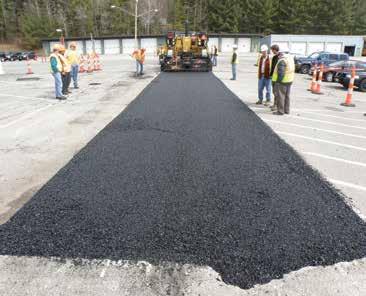
If the slope of the road is more than 5 percent on the surface, Baird said typical porous asphalt design is not appropriate. “The water stored in the reservoir course will travel to the low point and pond beneath the roadway,” he said. “The implications of this range from water being pushed back up through the pavement and frost heaving to loss of infiltration, to name only a few.”
Baird adds that slopes between 2 and 5 percent will require internal check dams or terraced grading of the infiltration layer below the reservoir course. “I like to grade the terraced layers at 0.5 to 1 percent ‘back’ towards the step in the terrace to account for variations in field conditions and construction accuracy, and to maximize infiltration opportunities,” he said. “Ultimately, flat bottoms are the ideal situation.”
POROUS PAVEMENT MIX DESIGN
Porous asphalt typically includes 1/2-inch stone—3/8 inch stone in New York—and very few fines. “Not having those fines is how you’ll get 20 percent air voids,” Barkevich said. New York specifies using different grades of asphalt binder such as PG64-22 S, E or V depending on the application. Liquid AC content is typically between 5.6 and 6 percent.
Porous mix designs should factor in local variations in aggregate and local temperatures.
“Because we don’t have fines in porous asphalt mixes, we run into issues with power steering scuff, raveling and starbursts,” Barkevich said, “especially in turning paths.” Using polymer-modified liquid protects the surface from these types of deterioration. He said it also helps to prevent the issue of drain down, where water moving through the pavement strips the surface of its AC and drags it to the bottom of the lift.
Cellulose fiber is often used to prevent drain down without choking the voids, however, New York state primarily uses polymer instead of fiber. If adding fiber, including basalt, cellulose, and blends including aramid, Baird suggests adding 0.3 to 0.6 percent by weight
LEFT: This photo from Baird shows an extreme case of inadequate temperature control, where the asphalt separated from the aggregate made it to the stone layers below, “leaving the asphalt surface in a ‘dry state; that raveled and crumbled the first 1 inch of the top course,” he said. RIGHT: This graphic and core illustrate the layers of the heavy duty porous pavement for Beach Road, constructed in 2013. To date, Beach Road is functioning as designed, Baird said.
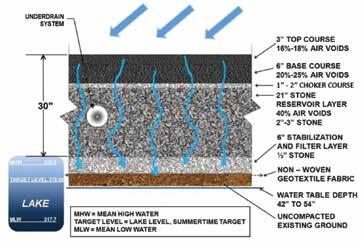
during the dry mix stage and increasing dry mix time by a minimum of 20 seconds.
Temperature, Baird said, is the most influential metric in the production and installation of porous asphalt. “Whether it is production, transporting or placement, nowhere in this process should temperatures exceed 295 degrees Fahrenheit,” he wrote in an article about the Beach Road project for the American Society of Highway Engineers.
Barkevich said production temperatures can also impact drain down during the production, transportation, and installation. “The higher the temperature, the less viscous a liquid AC is,” he said. “Without fines to hold it, a less viscous AC can really affect drain down with the asphalt binder ending up more highly concentrated in the lower portion of the lift, before the first vehicle even uses the new roadway.”
Barkevich suggests a production temperature of 275 degrees Fahrenheit, adding that warm mix projects are a great application for porous asphalt. Lower production temperatures are more feasible for porous pavements not only to combat the issue of drain down, but also because compaction of porous asphalt is different from traditional HMA compaction.
“On a normal mix, you have to get on there and get those air voids down to 5 to 6 percent in place,” he said, “but with porous asphalt, all we want to do is seat the material.”
Baird said the rolling temperature on porous projects is critical. The rolling temperature for the binder course should be between 200 and 240 degrees Fahrenheit, or up to 260 for cooler ambient temperature, and between 200 and 240 for the top course. Finish rolling should be between 140 and 150 degrees Fahrenheit for the binder course and 110 to 140 for the top course, with a cooling time to finish rolling of approximately four hours.
When paving porous asphalt, Baird recommends an ambient temperature between 50 and 70 degrees Fahrenheit with wind speeds ideally less than 3 mph.
He recommends four to six passes with a 10 to 12-ton static roller, operated slowly, “annoyingly slowly,” he reiterated.
CARING FOR A POROUS PAVEMENT
Taking care of a porous pavement begins during site planning.
“If we run construction traffic before we pave our permeable pavement, we’re compacting the sub-surface and significantly impacting or even eliminating infiltration,” Barkevich said. “But, you also don’t want construction traffic on top of your porous asphalt, choking it up.”
Barkevich suggests putting in an access road or leaving a high footprint from which to excavate down to the uncompacted subgrade immediately before building your porous system.
He also recommends posting a large sign that says Draining Pavement, “not only to applaud yourself for doing it, but also to protect your investment” from, for example, a site supervisor who might otherwise dump a load of topsoil on that pavement or a property manager who might apply sand to de-ice the pavement. Baird added that there are a few cases where parking lots have been unintentionally sealed.
“The University of New Hampshire did a bunch of research on snow and ice applications on porous pavement,” Barkevich said. The conclusion of their research was to use only salt on porous pavements—no sand, and no salt/sand combinations. “You’ll see a big decrease in your de-icing budgets for these porous applications, because they don't hold water or frost up as much as conventional pavements,” he added.
In the event that the surface course does get choked up with dirt and debris, it is possible to mill off the surface course and then clean, flush and perform infiltration tests on the underlying surface before putting a new porous surface on top of it. Although, of course, it's best to prevent choking your porous pavement in the first place.
Baird suggests vacuuming porous pavements two or three times per year and to deep clean promptly if an accident occurs. Sweeping is not recommended for porous pavement, as it could drive sediment into its pores. It’s also important not to seal po rous pavements.
